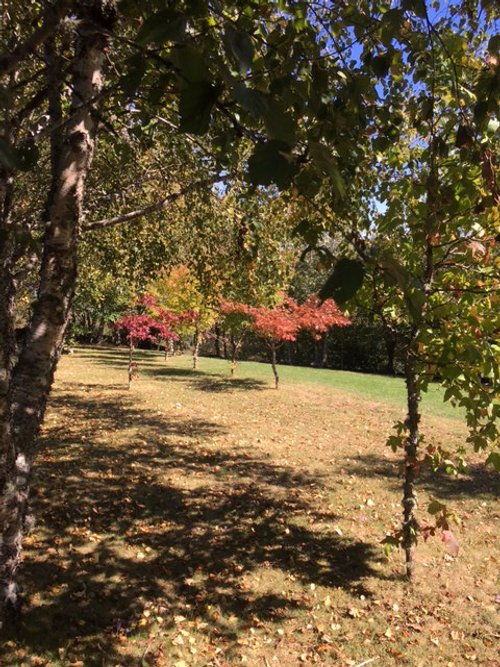October 2023
Most of the trees in the garden here were planted by the previous owners, and it is they who created the arrangement of saplings that I’ve come to call ‘the Birch Walk’. Birches grow everywhere in this area, so tiny ones were easy to uproot and replant, but it was the vision of how they would look 30 years later that determined the lovely feature that I’ve inherited. The parallel paths between the three rows of trees remind me of a classical academy, where learning took place in the course of walking, or an open-air cloister: you stroll down one path, then back along the other, absorbed in the moment. In dappled sunshine, when bars of light slant through the leaves overhead, it’s the perfect space for silent, solitary thought, or companionable conversation.
Copper beech with green companion
At this time of year, I’m grateful too that my predecessors sought out trees that bring fresh colour to the garden just as much of it is fading. The deep garnet foliage of two smoke bushes, modest in size when I arrived 13 years ago, now provides a focal point at the far end. Four red Japanese maples, the silvery undersides of their leaves upturned by every passing breeze, alternate with the autumnal orange of three liquid-ambers. Beeches are common here, but copper beeches are not, so I suspect the ones in this garden were bought and planted strategically to provide contrast. One copper beech, in fact, has a green compatriot growing right in front of it: a particularly happy pairing. Inspiration guided the choice of a linden, a hazel, two laurels and two flowering cherries.
And then there are the mushrooms that pop up unbidden all over the place, but especially along the Birch Walk. The ones that appear in the grass around the labyrinth are Macrolepiota excoriata and are edible, as long as they are big enough (the small ones are best avoided). Those that spring up among the birches tend to be Xerocomus chrysenteron, colloquially called a ‘boletus’ in these parts. These are technically edible but not very appealing, either in appearance or when compared to the true boletus: Boletus edulis, aestivalis, or penicola, commonly found growing under conifers. For visual charm it’s hard to beat Amanita muscaria - red with white spots, like something from a fairytale - but since it is poisonous, I leave it to its own capricious devices. In some years the Birch Walk is home to many of them, while in others, few – or only one. (Et in arcadia, ego….)
Japanese maples


